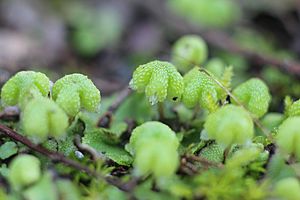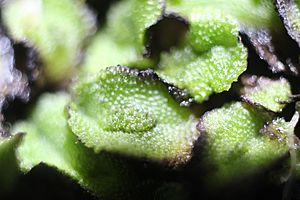Asterella californica facts for kids
Quick facts for kids Asterella californica |
|
|---|---|
 |
|
| Asterella californica female receptacles | |
| Scientific classification | |
| Kingdom: | |
| Division: | |
| Class: |
Marchantiopsida
|
| Order: |
Marchantiales
|
| Family: |
Aytoniaceae
|
| Genus: |
Asterella
|
| Species: |
A. californica
|
| Binomial name | |
| Asterella californica (Hampe ex Austin) Underw.
|
|
| Synonyms | |
|
|
Asterella californica is a special type of plant called a liverwort. It belongs to a group of plants known as Marchantiophyta. This plant often grows in groups, forming flat, rosette shapes.
Its leaves, called thalli, are usually light green and stiff. The underside of these thalli can be dark red or almost black. Asterella californica has special parts called receptacles. These are round with four lobes, and each lobe holds a single sporangium, which is like a tiny seed capsule.
This liverwort has separate male and female plants. You can often find them growing together. Asterella californica is common in California, from San Francisco all the way down to San Diego. It also grows on Guadalupe Island. It's the most common of the three Asterella species found in California. The other two are A. bolanderi and A. palmeri.
Contents
What Asterella californica Looks Like
These plants are pale green on top, with purple edges that curl upwards when dry. This shows off their dark purple undersides. The plant's body, or thallus, is usually simple or branches a few times.
It can be 8–25 mm long and often branches 1-3 times. The ends of the branches are often notched or heart-shaped. They are about 4–12 mm wide.
Asterella californica can dry out during long, rainless summers. But the tips of its branches stay alive. This means each living tip can start a new plant when it rains again. It's amazing how much of the plant can survive drying out. Just a few hours after getting water, the plant becomes active and starts to grow again.
How Asterella californica Reproduces
Asterella californica has different male and female plants, which is called being dioecious. This means they need both male and female plants to make new ones.
Male Plants and Sperm Release
Male plants have special structures called antheridia. These look like small, raised, oval or oblong discs. They are found along the middle of the plant, a bit back from the tip.
Scientists have observed that male Asterella plants can forcefully release their sperm cells. These sperm cells, called antherozoids, are tiny packets of cells with small hairs that help them move. Under the right conditions, Asterella can "throw" its antherozoids up to 14–20 cm high!
Female Plants and Their "Umbrellas"
Female plants have a unique "umbrella" structure called an archegoniophore. This structure stands tall above the plant's body. It's not the part that makes spores, but rather part of the plant that makes eggs.
The top part of this "umbrella" is called the female receptacle. It starts flat on the plant's surface, then a stalk grows to lift it up. The eggs, or archegonia, are found on this female receptacle. At first, they face upwards. They get fertilized when the stalk is still short.
As the stalk grows, the receptacle also grows. This moves the fertilized eggs outwards. The receptacle then folds over, so the developing spore-making parts face downwards. The stalk is usually straw-colored and 1–3 cm tall. The green disk of the receptacle is about 5 mm across and usually has four (sometimes five) deep lobes.
The Sporophyte and Spores
After fertilization, the plant develops a capsule. This capsule breaks open in the middle to release spores. The spores are yellow and quite large, about 100 to 120 µm in diameter. They have wavy "wings" along their edges, which are 12-20 µm wide.
The surface of the spores has a fine, net-like pattern. The plant also produces elaters, which are long, yellow, twisted cells. They are about 240-450 µm long. These yellow spores, with their distinct wings and fine patterns, are a unique feature of Asterella californica.
Naming and Classification
The name Asterella was first used in 1810. Later, in 1820, another name, Fimbriaria, was mistakenly used for this group of plants. However, Asterella is the older and correct name. The name Asterella means "little star." This refers to the star-like shape of the tiny pores on the plant's surface, which you can see from above in some species.
Where Asterella californica Lives
Asterella californica is very common and can be found in many places. It likes lightly shaded slopes, banks, and rocky areas. You can often find it in oak forests, chaparral (a type of shrubland), or desert scrub. It usually grows below 3000 feet in elevation, but can be found up to 7000 feet in some areas.
This liverwort grows throughout the Coast Ranges of California, the western Klamath Ranges, and the Sacramento Valley. It's also found on the west side of the Sierra Nevada mountains, along the coast of Southern California, and on the Channel Islands. Its range extends east to Arizona, north to southwestern Oregon, and south into northern Baja California. It typically grows on soil or among rocks in open or lightly shaded spots.


